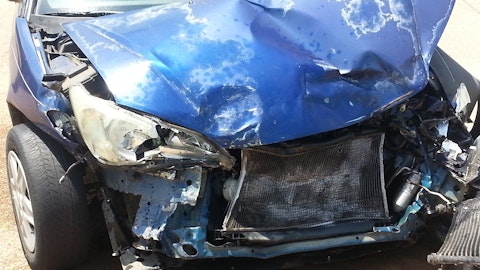We recently compiled a list of the 10 Worst Performing Healthcare Stocks in 2024. In this article, we are going to take a look at where Biogen Inc. (NASDAQ:BIIB) stands against the other healthcare stocks.
The Evolving Landscape of Global Healthcare Spending and Innovation
The healthcare industry remains a vital and resilient sector which is driven by advancements in technology, increasing global demand, and an aging population. ReportLinker projects that the healthcare services industry will grow from $7.5 trillion in 2022 to $7.975 trillion in 2023. It is anticipated to increase at a compound annual growth rate (CAGR) of 6.3%, or $9.8 trillion, through 2027. The global healthcare market is divided into several segments, including hospitals, digital health, and healthcare services. The hospital market alone is predicted to grow by 4.18% a year between 2024 and 2029, reaching a market value of $5.19 trillion.
In 2021, worldwide healthcare spending reached a record $9.8 trillion, or 10.3% of global GDP, according to a report released by the World Health Organization in December 2023. Spending was not uniformly dispersed, either, with low-income nations becoming more dependent on foreign help as government health spending declined. High-income nations spent about $4,000 per capita on health care, but 11% of the world’s population resided in nations that spent less than $50 per person. Even while public health spending increased during COVID-19, this trend is unlikely to continue because nations are dealing with issues like high inflation, weak growth, and mounting debt.
According to the Centers for Medicare and Medicaid Services (CMS), national healthcare spending is projected to reach an estimated $4.8 trillion in 2023 and grow at an annual rate of 5.6% between 2027 and 2032.
A patient-centered, technology-driven revolution is taking place in the healthcare industry. Thanks to the epidemic, telehealth has become widely accepted; in 2023, the global market was estimated to be worth $60.15 billion and is predicted to continue growing. By 2028, the genomics-driven precision medicine market, which provides individualized therapies based on genetic composition, is expected to reach $50.2 billion. With $31.5 billion in equity funding from 2019 to 2022 and the potential for $360 billion in annual US savings over the next five years, AI is also revolutionizing healthcare. The global market for remote patient monitoring (RPM), which was valued at $71.9 billion in 2023, is expected to continue expanding thanks to wearable technology.
Dr Bruce Aylward, WHO Assistant Director-General, Universal Health Coverage, Life Course, said:
“Sustained public financing on health is urgently needed to progress towards universal health coverage. It is especially critical at this time when the world is confronted by the climate crisis, conflicts, and other complex emergencies. People’s health and well-being need to be protected by resilient health systems that can also withstand these shocks.”
The Looming Collapse of U.S. Healthcare
The most concerning aspect of the healthcare industry is the looming collapse of the U.S. healthcare system, particularly in terms of workforce shortages and financial instability. The healthcare industry is facing a severe staffing crisis. By 2030, it is projected that 124,000 more physicians will be needed, and 800,000 registered nurses (RNs) are anticipated to leave the profession by 2027. The current turnover rate for staff RNs is a staggering 24%. This shortage has led to the closure of vital patient services, including Pediatrics, Psychiatry, Obstetrics, and ICUs in some healthcare systems.
Despite these challenges, the U.S. continues to spend nearly twice as much on healthcare as the OECD average, with worse outcomes on average. This disparity highlights the inefficiency and unsustainability of the current system. Additionally, 58% of hospital bad debt comes from insured patients, further straining the revenue cycle and limiting funds available for clinical services. The combination of these factors paints a grim picture of the U.S. healthcare system’s future. Without significant intervention and reform, the industry risks a systemic collapse that could have far-reaching consequences for public health and the economy.
Our Methodology
In our methodology, we used a stock screener to pick stocks with a market capitalization above $10 billion and assessed their year-to-date (YTD) returns. We subsequently identified those with underwhelming YTD performance as of November 11 and ranked them accordingly.
Why are we interested in the stocks that hedge funds pile into? The reason is simple: our research has shown that we can outperform the market by imitating the top stock picks of the best hedge funds. Our quarterly newsletter’s strategy selects 14 small-cap and large-cap stocks every quarter and has returned 275% since May 2014, beating its benchmark by 150 percentage points (see more details here).

A patient receiving physical therapy for a neurological disease.
Biogen Inc. (NASDAQ:BIIB)
Total YTD Return: -26.75%
Biogen Inc. (NASDAQ:BIIB) is a biotechnology company that develops therapies for neurological and neurodegenerative diseases, focusing on conditions like multiple sclerosis, Alzheimer’s, Parkinson’s, and spinal muscular atrophy. Its main products are prescription medications targeting these disorders.
Biogen Inc. (NASDAQ:BIIB)’s Alzheimer’s drug, Leqembi, has seen a slower-than-expected launch, struggling against competition from treatments like Eli Lilly’s Kisunla. Analysts question its market penetration and effectiveness, raising concerns about future revenues. Biogen’s pipeline is viewed as uninspiring, with limited innovative therapies, though promising developments like felzartamab for kidney transplant patients offer some hope.
In Q3 2024, Biogen Inc. (NASDAQ:BIIB) reported revenue of $2.5 billion, reflecting a 3% decrease compared to the same quarter in 2023. This decline was attributed to underperformance in its core pharmaceutical revenue streams, which also fell by 3%. Despite a 66% increase in global revenue from its Alzheimer’s drug, Leqembi, compared to Q2 2024, this growth was insufficient to offset losses from other products and overall market expectations.
Biogen Inc. (NASDAQ:BIIB) non-GAAP diluted EPS for Q3 was $4.08, down 6% year-over-year. While non-GAAP operating income increased by 4%, this was largely due to cost-cutting measures rather than significant revenue growth. The company’s focus on R&D prioritization and efficiency improvements has not translated into sustainable profitability or revenue growth, raising concerns among investors about the long-term viability of its financial strategies
Analysts have recently downgraded their outlook on Biogen, projecting limited catalysts for growth over the next year and suggesting that the stock may remain flat until at least 2026. Although some analysts maintain a “Moderate Buy” rating, the overall sentiment reflects caution due to ongoing challenges within the company and its competitive landscape.
As tracked by the Insider Monkey database, 49 hedge fund holders held shares in the company in Q3 2024, with RA Capital Management being the largest stakeholder with shares worth $229.5 million.
Overall BIIB ranks 6th on our list of the worst performing healthcare stocks in 2024. While we acknowledge the potential of BIIB as an investment, our conviction lies in the belief that AI stocks hold greater promise for delivering higher returns, and doing so within a shorter timeframe. If you are looking for an AI stock that is more promising than BIIB but that trades at less than 5 times its earnings, check out our report about the cheapest AI stock.
READ NEXT: 8 Best Wide Moat Stocks to Buy Now and 30 Most Important AI Stocks According to BlackRock
Disclosure: None. This article is originally published at Insider Monkey.





